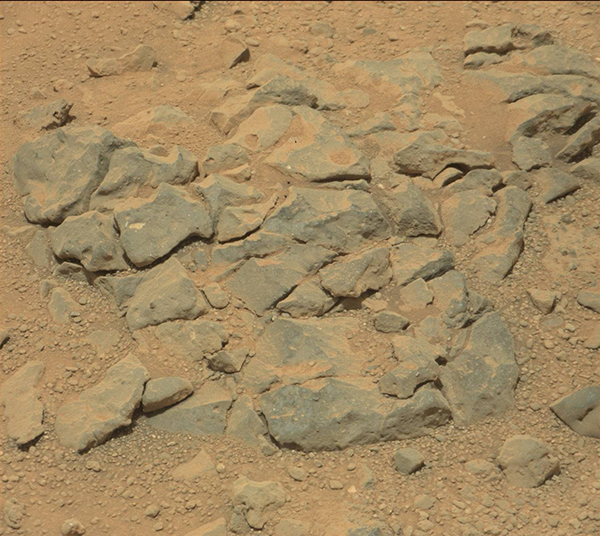
by Timothy Oleson Tuesday, March 18, 2014

Portions of this rock, dubbed Caribou and photographed with Curiosity's Mastcam, were analyzed on sol 342 using the ChemCam instrument and found to have a manganese-rich surface coating. Image: NASA/JPL-Caltech/MSSS
Several rocks on the surface of Mars are coated with distinctive dark-colored surface layers enriched in manganese that, while sharing similarities with manganese-rich rock varnish found on Earth, do not appear to be varnish themselves based on differences in trace element levels, according to new research presented Wednesday by Nina Lanza of Los Alamos National Laboratory at the Lunar and Planetary Science Conference (LPSC) in The Woodlands, Texas.
How the Martian rock coatings formed is not clear yet, but given proposed links between microbial activity and terrestrial manganese coatings, the evidence for high surface concentrations of manganese is still an intriguing twist for Mars researchers looking for signs of life there. (When contacted by EARTH prior to her presentation, Lanza declined to comment on the work, citing that it is under consideration for publication in an unspecified journal. Scroll down to read tweets posted from LPSC about the presentation.)
Basalt coated in dark rock varnish, into which early Americans etched illustrations as seen here, is a common site at Petroglyph National Monument near Albuquerque, N.M. Image: Timothy Oleson
“Because of the close association between manganese minerals and microbial activity on Earth, manganese-oxides have been suggested as potential biosignatures for Mars missions,” Lanza and her colleagues wrote in the conference abstract describing the research.
Rock varnish is most associated with arid desert environments on Earth, though it is found in other settings as well, and forms thin coatings — typically microns to hundreds of microns thick — that are thought to grow at rates on the order of a just few microns per thousand years. Composed predominantly of clay particles, varnish gets its characteristic dark reddish to brown-black coloration from the iron and manganese oxides that cement the clays together and bind them to the underlying rock.
The Martian rocks, located in Gale Crater where NASA’s Curiosity rover has been exploring since August 2012, were analyzed using the rover’s ChemCam tool, which includes a laser induced breakdown spectroscopy (LIBS) instrument. LIBS zaps tiny spots with laser pulses to etch away small portions of rock, measuring the composition of material as it is ablated. With each sequential pulse, the laser digs deeper into a rock and, thus, a compositional depth profile can be determined.
Lanza and her colleagues looked at data from about 1,800 individual spots on roughly 400 rocks analyzed during Curiosity’s first 360 sols (Martian days) on the Red Planet. In 15 of these spots, they identified distinct peaks in manganese content after the first three laser pulses — thought to clear dust from the rocks’ surfaces — followed by gradual declines in the amount of manganese.
Comparing the results to the same type of analysis performed on a terrestrial sample of manganese-rich rock varnish showed “a similar systematic decrease in manganese peak intensity with depth, suggesting that these Martian observations are consistent with a manganese-rich coating,” Lanza and her colleagues wrote.
“The discovery of high concentrations of manganese on Martian rocks is significant” and “extremely exciting,” says Barry DiGregorio, a research associate at the Buckingham Centre for Astriobiology in England who has investigated terrestrial varnish formation and was among the first researchers, in 2001, to suggest that dark coatings on Martian rocks observed by earlier missions could be manganese-rich varnish with the potential to host life.
The manganese concentrated in rock varnish is thought to be leached from dust that lands on rock surfaces and is then weathered in the presence of water. Evidence of manganese-oxidizing bacteria is sometimes found on varnish-covered rocks, but whether they are necessarily involved in its production, or if they act in some cases to enhance varnish formation — perhaps by further concentrating manganese and iron — or if the association is merely coincidence, is still debated. As Lanza and her colleagues noted in their abstract, some researchers have suggested that “manganese-rich coatings may also form abiotically,” without any assistance from microbes.
“The Martian and terrestrial comparisons in the Lanza et al. abstract look remarkably consistent,” DiGregorio told EARTH, adding that “Mars has all the right ingredients for varnish formation today: clay minerals, suitable pH” and evidence of “brief wetting periods from melting snow and ice.” Still, he says, it is “difficult to know” exactly what they’ve found at this point.
Lanza’s team wrote that the detection of manganese “in excess of a typical Martian basalt provides intriguing evidence for water-rock interactions in a habitable environment,” though the “nature of the high, trending manganese detections from ChemCam is not yet clear.”
Now that they’ve “confirmed the presence of manganese oxides as rock coatings, you can bet they are going to make more in-depth [rock] profiles, likely in conjunction with some of the other instruments,” DiGregorio says. Perhaps, he says, “Curiosity’s SAM [Sample Analysis at Mars] instrument might look for organics in scrapings.”
© 2008-2021. All rights reserved. Any copying, redistribution or retransmission of any of the contents of this service without the expressed written permission of the American Geosciences Institute is expressly prohibited. Click here for all copyright requests.